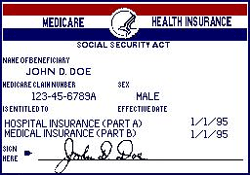Medicare is the federal (national) health insurance program for Americans age 65 and older and for certain disabled Americans. If individual is eligible for Social Security or Railroad Retirement benefits and are age 65, he and his spouse automatically qualify for Medicare.
Medicare has two parts: hospital insurance, known as Part A, and supplementary medical insurance, known as Part B, which provides payments for doctors and related services and supplies ordered by the doctor. If individual is eligible for Medicare, Part A is free, but insured must pay a premium for Part B. 
Medicare will pay for many of insured health care expenses, but not all of them. In particular, Medicare does not cover most nursing home care, long-term care services in the home, or prescription drugs. There are also special rules on when Medicare pays patient’s bills that apply if patient have employer group health insurance coverage through his own job or the employment of a spouse.
Medicare usually operates on a fee-for-service basis.
Some people who are covered by Medicare buy private insurance, called "Medigap" policies, to pay the medical bills that Medicare doesn't cover. Some Medigap policies cover Medicare's deductibles; most pay the coinsurance amount. Some also pay for health services not covered by Medicare. There are 10 standard plans from which individual can choose (some States may have fewer than 10.) If an individual buy a Medigap policy, he should make sure that he does not purchase more than one.
Subscribe to:
Post Comments (Atom)
Post a Comment